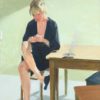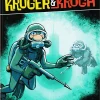In our gallery we have many artworks; Drawings, paintings, sculptures, prints – differing in size and expression, from figurative to nonfigurative.
But when we write about art, it can sometimes be a bit confusing for nonprofessional’s to distinguish between different “isms” and terms. For instance, what is the difference between figurative, abstract and nonfigurative art?
Let us try to explain in a very simple way:
Figurative art depicts an object, a person, nature etc. In other words, art that can be defined by the viewer. Da Vinci´s Mona Lisa or David Hockney´s “A Bigger Splash” are known examples.
Translated from Latin, abstract means “to derive the essential properties from something concrete”. To put it simply, abstract art lies on a scale between figurative and non-figurative.
It derives from a concrete object, but the connection to the visible and concrete reality is reduced or even abolished.
Piet Mondrian is a well-known abstract painter, with works such as ” Broadway Boogie Woogie”, while Barbara Hepworth was an influential abstract sculptor, who used the human body as inspiration for her works.
At the other end of the scale we have non-figurative art, i.e. art that does not represent or imitate objects at all, but where forms, lines and colours constitutes the motive. Examples of this art form are Mark Rothko´s “№5/№22» and Agnes Martins´ glistening gold icon «Friendship».
To repeat: Nonfigurative and figurative art are mutually exclusive, but the opposition is smoothed by abstract art. And: It´s important to note that none of these terms are styles, but just descriptions of any art that does or avoids imitation.
To summarise with examples from our own gallery we have the beautiful, figurative drawings of Vanna Bowles and Gry Hege Rinaldo, the abstracted drawings of Magnar Moen and Gitte Sæthre´s “Geo Political Landscapes” paintings, and finally the nonfigurative works of Marius Martinussen (photo: “U-turn) and Gelah Penn.
Just to name a few that deserves your attention.




